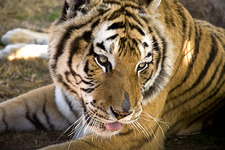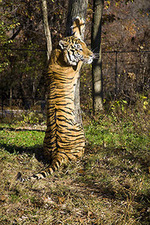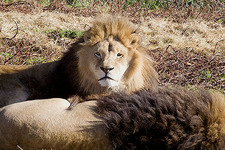by Judith Fein
Achoo. Scratch scratch. That is my response to dogs, cats and anything that has more than two feet and is covered with hair. My eyes blow up. I wheeze. I get a je-ne-sais-quoi hairball thing in my throat. And how can I help offending friends who are in love with their Poopsies and KitKats? All I can think about is: get me home so I can throw my clothes and myself in a washing machine. © Paul Ross.But it’s different when the hirsute ones are out of doors. I went on a safari in South Africa and got so close to the lions, zebra, tigers, elephants and giraffes that I could see the whites of their eyes. No wheezing, no sneezing. I actually bid on a baby camel at a livestock auction in Tunisia, but I couldn’t figure out how to build a camel pen in my bedroom that would filter out airborne (hair) allergens.
© Paul Ross.But it’s different when the hirsute ones are out of doors. I went on a safari in South Africa and got so close to the lions, zebra, tigers, elephants and giraffes that I could see the whites of their eyes. No wheezing, no sneezing. I actually bid on a baby camel at a livestock auction in Tunisia, but I couldn’t figure out how to build a camel pen in my bedroom that would filter out airborne (hair) allergens.
After a long hiatus from the animal kingdom, which corresponded to my running out of Benadryl, I happened to be in Northwest Arkansas, and heard there was the largest big cat reserve in the country at Turpentine Creek in Eureka Springs. Beloved by the NW Arkansas citizens, it inspired local giants Walmart and Tyson to donate about 300,000 pounds of chicken, turkey, beef, fish and pork every year to feed the beasts. And visitors can sponsor an animal and even choose its name. Hey, I’m a sucker for feel good things, so off I went.
Outside the main door to the reserve, Tanya South—one of the founders of Turpentine Creek— cradled a black baby leopard in her arms. I patted the little darlin’ on the head and entered the reserve for rescued cats.  I walked along a half-mile loop and was able to observe the Big Guys in fenced-in areas that are as close to a natural habitat as the reserve can provide for them.
I walked along a half-mile loop and was able to observe the Big Guys in fenced-in areas that are as close to a natural habitat as the reserve can provide for them.
Do you know that the domestic cat is the only species able to hold its tail vertically while walking? In case you can’t tell the difference between your friends’ feline and a lion, the latter holds its tail horizontally or tucked between its legs while walking. Remember this. It can be useful if you ever land on a game show.
How about this—cats purr at the same frequency as an idling diesel engine, which is about 26 cycles a second.
Most people who work in the reserve are biologists or zoologists, so learning is a big part of the experience for visitors.  © Paul Ross.And what about the lions, pumas and panthers, you wonder? They are there for life. They or their parents have been rescued and they haven’t been taught to hunt, so they can’t go into the wild. Their habitats give them the maximum amount of room possible to play with toys, stalk, pace, and pee.
© Paul Ross.And what about the lions, pumas and panthers, you wonder? They are there for life. They or their parents have been rescued and they haven’t been taught to hunt, so they can’t go into the wild. Their habitats give them the maximum amount of room possible to play with toys, stalk, pace, and pee.
Yes, my friends. These cats sure know how to spray. As I walk by, a 400-pound tiger named Sissy lifts her tail and shoots out a wicked stream that almost douses a visitor. The latter walks away to gawk at Ziggy, who has the biggest head of any cat I’ve ever seen in my life.
“There’s a whole language of urine we’re just beginning to understand,” says Scott, my guide. And when he sees a spark of interest in my eyes, he adds, “Do you know that the farther away you get from the Equator, the bigger and lighter the cats are?”
When the sun goes down, you can stay at one of the cabins on the grounds. It doesn’t get much cooler than this. From your bedroom window, you can peer into the cages and watch the beasties. Or you can walk around the grounds and visit your new feline friends as you listen to the high-pitched cougar screech, the low growl of tigers or the caroling of lions. This is nature’s music.
“We love all the cats,” says Tanya. “About ten years ago my mom did mouth-to-mouth resuscitation on a baby big cat. A visitor filmed it. It was on Animal Planet.”
Turpentine Creek now has bears, too, and they post bios of all the animals online.
I am hooked. You’d be hooked too, and probably ready to adopt one of the big cats for $100 a year or, if the recession continues, you can share an adoption.
Judith Fein is an award-winning travel journalist who has contributed to more than 80 publications. She also gives travel talks, teaches travel writing and sometimes takes people on exotic adventures. Her website is www.globaladventure.us
photography by Paul Ross.